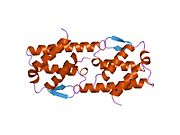Interleukin 5
Interleukin 5 (IL-5) is an
Function
Through binding to the
Structure
IL-5 is a 115-
Tissue expression
The IL-5
Clinical significance
IL-5 has long been associated with the cause of several allergic diseases including allergic rhinitis and asthma, wherein a large increase in the number of circulating, airway tissue, and induced sputum eosinophils have been observed.[7] Given the high concordance of eosinophils and, in particular, allergic asthma pathology, it has been widely speculated that eosinophils have an important role in the pathology of this disease.[8]
As of 2019, there are two FDA-approved
Some hydroxyethylaminomethylbenzimidazole analogs have shown IL-5 inhibition in vitro.[12]
Effect on eosinophils
Eosinophils are terminally differentiated
In Hodgkin lymphoma, the typically-observed eosinophilia is thought to be attributable to an increased production of IL-5.[15]
Interactions
IL-5 has been shown to
Receptors
The IL-5 receptor is composed of an α and a βc chain.[19] The α subunit is specific for the IL-5 molecule, whereas the βc subunit also recognised by interleukin 3 (IL-3) and granulocyte-macrophage colony-stimulating factor (GM-CSF).[19][20] Glycosylation of the Asn196 residue of the Rα subunit appears to be essential for binding of IL-5.[21]
References
- S2CID 4254991.
- S2CID 41719900.
- PMID 2564789.
- PMID 8294877.
- PMID 8179909.
- S2CID 25517499.
- PMID 12626589.
- PMID 1596561.
- ^ "Anti-interleukin-5 therapy for severe asthma: A new therapeutic option". Mayo Clinic. 8 January 2019. Retrieved 14 December 2023.
- S2CID 253457684.
- PMID 34292606.
- S2CID 199527755.
- PMID 10353986.
- PMID 3486243.
- PMID 8688671.
- PMID 7957082.
- PMID 7721873.
- PMID 1732409.
- ^ S2CID 54277241.
- PMID 8496674.
- PMID 21770429.

